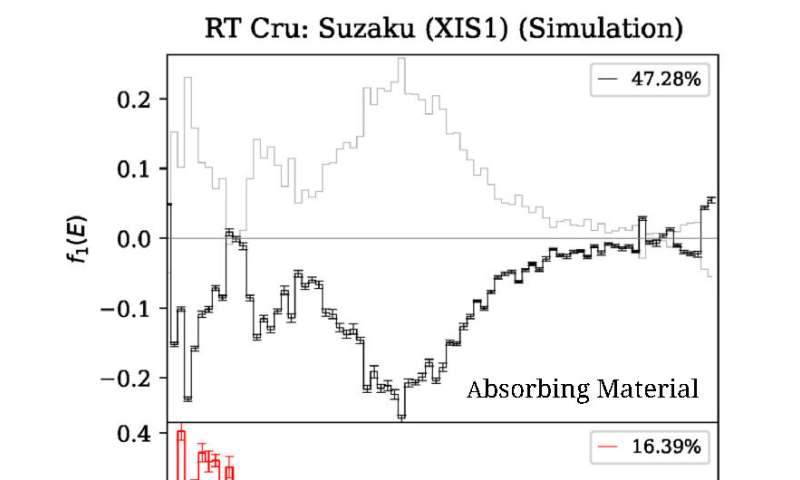Symbiotic binary stars are a type of binary star system that consists of a compact star (such as a white dwarf) and a red giant star. In these systems, a compact star accretes materials from a red giant star and produces soft X-ray photons. However, some of them—known as hard X-ray-emitting symbiotic stars—also produce powerful X-ray photons, which may be due to the presence of massive white dwarfs.
Observations with X-ray telescopes show that many of the hard X-ray-emitting symbiotic stars emit plasma emissions with different temperatures: cool (soft) and hot (hard). Astronomers also discovered jets in some of these stars, which could potentially form a shock region and contribute to the formation of soft/cool plasma emissions.
X-ray observations of one of the hard X-ray-emitting symbiotic stars, named RT Crucis, also known as RT Cru, reveal the presence of a soft thermal plasma emission. In 2021, we used the Chandra telescopes and a Bayesian statistical method to find the evidence for a hard thermal plasma emission in RT Cru. The emission could occur between the accretion disk’s inner layer and the white dwarf’s surface.
X-ray variability in a symbiotic star as decomposed by dimension reduction
Other astronomers also noticed a drop in optical emission lines and hard X-ray photons in the X-ray-emitting symbiotic system RT Cru in 2019. They think this might be because of a decline in some accretion activities. The high variability in X-ray photons suggests that dense materials may block the soft thermal plasma emission.
To find the origin of variability in X-ray photons from RT Cru, we recently used principal component analysis (PCA), which is a dimensionality reduction method often used in data preparation for machine learning.
This method allows us to deconstruct temporally variable spectral data into main spectral components and corresponding time series showing temporal variation. Principal component analysis can be used to determine the minimum number of principal components required for X-ray photon variability.
In our research published in The Astrophysical Journal, we observed that the X-ray photons from RT Cru collected in 2012 were brighter than those taken in 2007, and hourly flickering variations are also visible in both observations.
-

The main components of the variability in X-ray photons from RT Cru revealed by principal component analysis: absorbing materials, absorbed X-ray source, and soft plasma emission. Credit: The Astrophysical Journal (2024). DOI: 10.3847/1538-4357/ad5cf6
-

The main components of the variability obtained from the simulated X-ray photons made with variations in absorbing materials, X-ray source, and soft plasma emission. Credit: The Astrophysical Journal (2024). DOI: 10.3847/1538-4357/ad5cf6
Origins of the variability in X-ray photons from the symbiotic star RT Cru
We learned that the main spectral components seen in observations made with the Chandra and XMM-Newton space telescopes, which cause the changes in X-ray photons, might be linked to varying soft thermal plasma emission. We also discovered that changes in X-ray photons seen with the Suzaku space telescope between 2007 and 2012 are probably caused by changes in absorbing material as well as variation in the X-ray source linked to accretion activities.
There is also evidence for heavily obscured, soft thermal plasma emission in the Suzaku observations. Therefore, changes in the obscuring material and the X-ray source in the accretion disk primarily contribute to the spectral changes across the two observations in 2007 and 2012.
Other astronomers reported a significant decrease in hard X-ray photons in 2019, which they potentially linked to a decrease in the amount of material accreting into the white dwarf. We also simulated the variability in X-ray photons, demonstrating that variations in the density of absorbing material and the X-ray brightness of the source due to accretion processes could lead to long-term spectral changes.
Symbiotic binary stars frequently flicker, a phenomenon linked to accretion physics. This behavior is demonstrated by RT Cru, a hard X-ray-emitting symbiotic binary system, with variations ranging from seconds to hours. Astronomers have observed this behavior in a wide range of electromagnetic waves, from optical to UV and X-ray.
Our computer simulations of the changes in X-ray photons also show that soft plasma emission changes may cause fast flickering-type variations, which are likely to come from a zone of the accretion disk around a massive white dwarf.
Future X-ray space telescopes with higher sensitivity, such as the proposed Arcus X-ray spectrometer, will be better equipped to capture the cause of flickering-type phenomena in symbiotic binary stars.
This story is part of Science X Dialog, where researchers can report findings from their published research articles. Visit this page for information about Science X Dialog and how to participate.
More information:
A. Danehkar et al, X-Ray Variability in the Symbiotic Binary RT Cru: Principal Component Analysis, The Astrophysical Journal (2024). DOI: 10.3847/1538-4357/ad5cf6
Ashkbiz Danehkar is a research scientist at Eureka Scientific (USA). Danehkar formerly worked as a research fellow at the University of Michigan (Ann Arbor, MI) and was a postdoctoral fellow at the Harvard-Smithsonian Center for Astrophysics (Cambridge, MA) after pursuing a PhD at Macquarie University (Sydney, Australia). Danehkar has conducted research on symbiotic binary stars, ionized gaseous nebulae, outflows in active galactic nuclei, and starburst superwinds.
Citation:
Origins of variability in X-ray photons from a symbiotic binary star as revealed by dimensionality reduction (2024, September 2)
retrieved 2 September 2024
from
This document is subject to copyright. Apart from any fair dealing for the purpose of private study or research, no
part may be reproduced without the written permission. The content is provided for information purposes only.